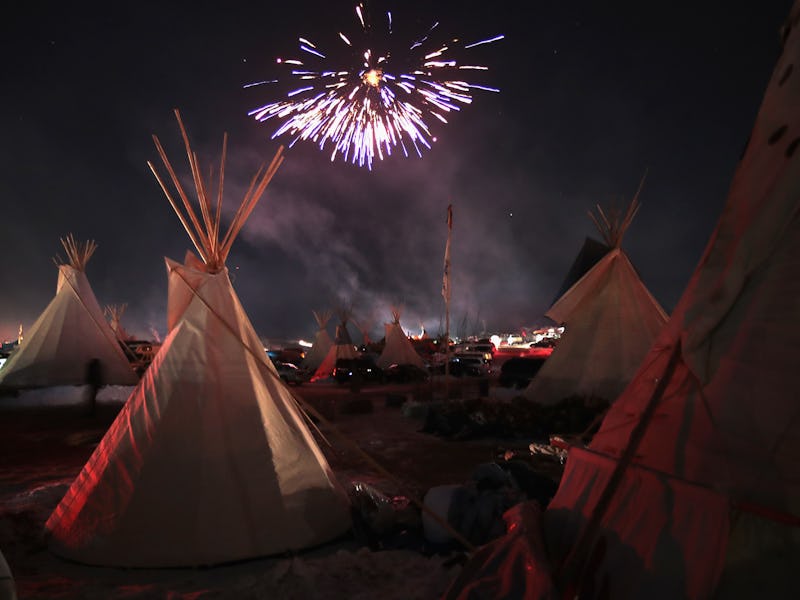"Protesting Works" Is the Cry After DAPL Decision in Standing Rock
"Don't ever let someone tell you protesting does not work."

On Sunday, Jo-Ellen Darcy, the Army’s Assistant Secretary for Civil Works, announced her decision to not approve permits for further construction of the Dakota Access Pipeline. Darcy cited the need to “explore alternate routes for the pipeline crossing,” so that it wouldn’t move oil beneath a water supply and possibly disrupt Native American burial grounds. In the wake of Darcy’s announcement there were a dozen conclusions and predictions One of the most-claimed: Protesting and activism, whether it be motivated by science or social stimuli, still actually works.
The written decision from Darcy, a one-time elementary school teacher who’s spent the better part of 30 years evaluating and protecting natural water supplies, makes no mention of the protests in icy water and freezing temperatures, or the #NoDAPL tweets or numerous fundraisers around the country to support the Standing Rock Sioux Tribe’s DAPL Fund.
On Sunday night, the popular opinion though, was that protesting works, with representative remarks like this one:
And this one:
There are a few academic studies that seem to support the idea that protesting works. A 2010 University of Missouri study of activism in 17 Latin American countries going back to 1978 found that “although political protests can be violent, they can lead to stronger political parties and more responsive policies.” Additionally, numerous studies since then have found that while social media-based activism, often discredited as “slacktivism” — even if it has real-world effects, like checking into Standing Rock on Facebook — actually has a positive effect on real-world participation.
For now, it looks like Darcy’s decision could have costly consequences for Energy Transfer Partners, the company that’s building the pipeline from northwestern North Dakota to downstate Illinois. For one, lengthy environmental impact studies need to be conducted in order for alternative routes to be explored for the pipeline.
The route. The contested and protested area is in the southern part of North Dakota.
The consequences of Darcy’s decision will almost certainly be expensive: The near-complete pipeline should have been finished by now and lawyers for Energy Transfer Partners have said in court that shipping contracts will expire and the project would ultimately get more expensive. So while the pipeline project will in all likelihood still be finished, it won’t be built beneath a water supply for a Native American community and won’t destroy burial grounds.
Conservative pundit and internet creation Tomi Lahren, who experienced a meteoric rise this summer, told Trevor Noah last week that protesting doesn’t work during an exchange too painful to watch more than once. It might have been easy to believe her, especially for anyone who watched post-election protests against Donald Trump and wondered where the crowds were before the election, seemingly defying President Obama’s call of “don’t boo, vote.” Trump got all the right votes in all the right places and he’s now president-elect, which means those post-election protests are likely to give way to four more years of activism if his promises are any indication of what’s to come. And the pipeline’s probably going to keep going after it gets rerouted.
This time, though, it seems that activism did the job, if only temporarily. The New York Times reminded readers on Sunday that this project is most definitely, probably, going forward.
President-elect Donald J. Trump, however, has taken a different view of the project and said as recently as last week that he supported finishing the 1,170-mile pipeline, which crosses four states and is almost complete. Mr. Trump owns stock in the company building the pipeline, Energy Transfer Partners, but has said that his support has nothing to do with his investment.
Native American and other activists celebrate after learning an easement had been denied for the Dakota Access Pipeline at Oceti Sakowin Camp on the edge of the Standing Rock Sioux Reservation on December 4, 2016 outside Cannon Ball, North Dakota.
Supporters of the pipeline project — which is going to move 550,000 barrels a day — say the denial is a move by President Barack Obama during his final days in office. But for those against it, especially the Standing Rock tribe and their activist allies, Sunday’s decision feels like nothing less than a victory.